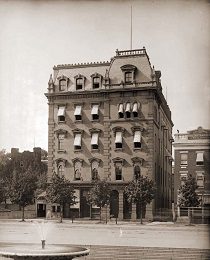Special thanks to our guest contributors, Alexandria Halmbacher and Lakisha Higgins, from the Federal Reserve Bank of Cleveland!
Not many people know that the Federal Reserve Bank of Cleveland is a resource that educators and students can use to learn about topics such as economics, career readiness, history, finance, financial literacy and more. While the Federal Reserve is best known for serving as the Central Bank of the United States and enacting monetary policy, it also has a robust educator resource library with thousands of free classroom-ready resources that span lesson plans, activities, videos, games, infographics, apps, e-books, and more.
In celebration of Black History Month, we’ve highlighted a few resources that explore the history of black banking in the United States, a history and legacy that remains largely unknown to many Americans today.

(Figure 1: Freedman’s Saving and Trust Company Headquarters in New York, 1865.)
Efforts to establish America’s first African American banks were an important part of the fight for equality. After the end of the Civil War, Black soldiers needed a place to deposit their earnings. The solution was Freedman’s Savings and Trust Company created by an act of Congress in 1865. Headquartered in New York City, Freedman’s eventually operated 37 branch locations across the South. Despite the services provided by private lenders and Freedman’s, the majority of Black Americans still struggled to find equal economic opportunities in the years following the Civil War and Reconstruction. It was from churches, fraternities, and mutual aid societies that America’s first Black owned and operated banks began. Between 1888 and 1890, The Savings Bank of the Grand Fountain, United Order of True Reformers, Capital Savings Bank, and Alabama Penny Savings Bank were established. While hundreds of other banks closed nationally during the banking panics that plagued America between 1893 and 1895, these banks survived and led the way for many others.
To learn more about this history, explore the resources below.